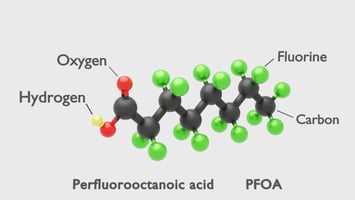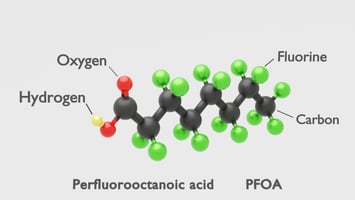Did you know that rain jackets are now switching to PFAS-free? Here we will explain the advantages...
What is PFAS issue in Japan?
The other day, NHK (i.e., Japan's national broadcaster) was covering the PFAS issue. As one would expect from NHK, none of the content was wrong. However, I was worried that the general public would not understand the exquisite phrasing and excuses. Japan is not an advanced country in terms of PFAS issues, but by taking up the PFAS issue in Japan this time, we hope to trigger further discussion of the PFAS issue.
What are PFAS in the first place?
PFAS is a generic term for organofluorine compounds. Simply put, it means a compound in which fluorine and carbon are linked.
To be precise, it is a perfluoroalkyl compound, so the hydrogen in the alkyl group is replaced by fluorine, and it is called a carbon-fluorine bond, but it is now recognized as a compound with a bond between carbon and fluorine. Since the detailed definitions vary according to the organizations and societies that use them, there are thousands and thousands of different types. This means that a unified definition is not possible, so don't worry about the details and just understand that it is a compound with a bond between carbon and fluorine, as I mentioned earlier.
What are the characteristics of PFAS?
PFAS is characterized by its persistence. The bond between carbon and fluorine can be said to be the strongest chemical bond. Therefore, it is very difficult to decompose naturally in the environment, and depending on the environment, it may take hundreds or even thousands of years.
Fluorine exists in nature, but PFAS, with its carbon-fluorine bond, does not exist in nature. The fact that this artificial compound remains in the earth's environment for so many years is considered problematic.
PFASs are also found in air pollution, but the problem is even more serious when they are ingested through water. What is the problem with PFAS?
What are the problems with PFAS?
To name the problems with PFAS involves a bit of difficulty.
The one thing that can be said without a doubt is that it is an environmental problem. No scholar would dispute this. What is controversial, however, is the impact on the human body. It is known that there is an effect on the human body, but the extent of that effect is a matter of debate. In Japan, it is sometimes reported definitively that there are effects on the human body, but in reality, there are many aspects that are not well understood, although there is a possibility. And these are just some of the PFOA and PFOS that used to be commonly used, not all of the PFAS are known.
However, it does not mean that we can use them because we do not know them well, but rather that we should stop the specification and production of those that may be harmful, and some PFAS are already regulated in some countries as well as Japan. In addition, some countries outside of Japan have begun efforts to make all PFAS subject to regulation.
What is the PFAS problem in Japan?
Even though PFAS is called PFAS, the PFAS problem in Japan is limited to two issues, PFOA and PFOS. As for regulations, PFOS will be regulated in 2010, PFOA in 2021, and PFHxS in 2022. The rest are not zero, but at this point, PFOA or PFOS are so problematic that the rest are rarely looked at.
It is also difficult to speak of PFOA and PFOS in the same breath, as the two are essentially one and the same. They are different from each other and have different characteristics. Of course, they also have different effects on the human body. In fact, even the manufacturing methods are different, so they are not manufactured together. Therefore, in the case of Japan, whether PFOA or PFOS is detected is an important source of information. For example, neither Daikin Industries nor AGC, the major fluorine producing chemical companies in Japan, have any experience in the production of PFOS, and PFOA production was discontinued by 2015. Based on these circumstances, the source of PFAS is estimated based on whether PFOA or PFOS is detected more prominently.
What are the sources of PFAS in Japan?
As mentioned above, in Japan, it is either PFOS or PFOA that is the problematic PFAS. Since Daikin Industries and AGC, Japan's major fluorochemical manufacturers, have no manufacturing experience with PFOS, if PFOS is detected, it is basically considered to be coming from imported products. On the other hand, PFOA is manufactured in Japan (and contained during manufacturing), so it is detected in the vicinity of manufacturing plants, etc.
The above trend is well manifested, and PFOS is highly detected in rivers and soil near U.S. military bases because PFOS is used as a surfactant in foam fire extinguishing agents. In addition, high levels of PFOA have been detected in rivers and soil near factories that used to manufacture PFOA.
On the other hand, secondary damage cannot be overlooked. Activated carbon is often used to remove PFOA, but when the activated carbon used to remove PFOA is left out in the open, rain and other factors cause it to flow out, resulting in high concentrations of PFOA being detected in rivers near where it was left.
Media Coverage of PFAS in Japan
Media coverage of PFAS in Japan has been symbolic of the human suffering caused by PFAS to give the impression that it is a dangerous substance. And the recent trend has been to report that the government has not taken proactive measures against PFAS on the grounds that the scientific evidence is insufficient, by comparing them with overseas cases, especially with the U.S. standards.
The argument is that the content standards for PFOA and PFOS are high compared to the U.S. standards and that the regulations are lenient.
What is worrisome is that the issue is rarely addressed as an environmental issue. There is no mention of the fact that PFAS, a man-made substance, is emitted and remains in the environment for a long time, which is the problem.
PFAS Regulations
Japan's PFAS regulations lag behind the rest of the world. This is because Japan's basic stance is to regulate only those products for which scientific evidence has been confirmed, as the idea of regulating questionable products is not very familiar to the Japanese. Currently, there are only three types of chemicals regulated in Japan: PFOS, PFOA, and PFHxS.
Globally, while legislation is being enacted to regulate all PFAS, the use of some for special purposes is permitted, and the trend toward complete elimination has not yet been reached. It may be our responsibility to start working on the areas where alternatives are possible, except for those that are absolutely necessary. It will be interesting to see how Japan implements PFAS regulations in the future.



